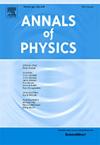非旋转黑洞时空中奥森巴哈效应背后的机制
IF 3
3区 物理与天体物理
Q2 PHYSICS, MULTIDISCIPLINARY
引用次数: 0
摘要
广义相对论预言,旋转的黑洞由于其自旋而拖拽时空。这种效应会影响附近物体的运动,导致它们要么落入黑洞,要么围绕黑洞运行。在经典牛顿力学中,随着轨道半径(r)的增加,物体在稳定圆形轨道上的角速度(Ω)减小。然而,Aschenbach发现,对于一个假设的不旋转的观察者,与通常的行为相反,角速度在某些区域随半径增加(Aschenbach, 2004)。虽然在旋转结构中观察到罕见和不太可能的“旋转”行为的可能性并非不可能或不可能。然而,在“静态”结构中观察这种行为不仅有趣,而且发人深省,因为它提出了可能在这种现象中起作用的因素的问题。在寻找这个问题的答案时,研究了各种静态模型,特别是在非线性场的背景下,并在文章中作为示例提供了一些结果。在研究的模型中,四维爱因斯坦-高斯-邦纳质量引力耦合非线性电动力学的磁性黑洞模型(m - egb - mass)似乎是这一现象的候选模型。在分析部分中,我们将讨论此模型与先前显示此现象的模型的共性,并研究此现象的原因。最后,我们将说明这种现象是否可以在其他黑洞中观察到,如果不能,为什么。本文章由计算机程序翻译,如有差异,请以英文原文为准。
Mechanisms behind the Aschenbach effect in non-rotating black hole spacetime
General relativity predicts that a rotating black hole drags the spacetime due to its spin. This effect can influence the motion of nearby objects, causing them to either fall into the black hole or orbit around it. In classical Newtonian mechanics, as the radius (r) of the orbit increases, the angular velocity () of an object in a stable circular orbit decreases. However, Aschenbach discovered that for a hypothetical non-rotating observer, contrary to usual behavior, the angular velocity increases with radius in certain regions (Aschenbach, 2004). Although the possibility of observing rare and less probable ”rotational” behaviors in a rotating structure is not unlikely or impossible. However, observing such behaviors in a “static” structure is not only intriguing but also thought-provoking, as it raises questions about the factors that might play a role in such phenomena. In seeking answers to this question, various static models, particularly in the context of nonlinear fields, were examined, with some results presented as examples in the article. Among the models studied, the model of Magnetic Black Holes in 4D Einstein–Gauss–Bonnet Massive Gravity Coupled to Nonlinear Electrodynamics (M-EGB-Massive) appears to be a candidate for this phenomenon. In the analysis section, we will discuss the commonalities of this model with previous models that have exhibited this phenomenon and examine the cause of this phenomenon. Finally, we will state whether this phenomenon is observable in other black holes and, if not, why.
求助全文
通过发布文献求助,成功后即可免费获取论文全文。
去求助
来源期刊

Annals of Physics
物理-物理:综合
CiteScore
5.30
自引率
3.30%
发文量
211
审稿时长
47 days
期刊介绍:
Annals of Physics presents original work in all areas of basic theoretic physics research. Ideas are developed and fully explored, and thorough treatment is given to first principles and ultimate applications. Annals of Physics emphasizes clarity and intelligibility in the articles it publishes, thus making them as accessible as possible. Readers familiar with recent developments in the field are provided with sufficient detail and background to follow the arguments and understand their significance.
The Editors of the journal cover all fields of theoretical physics. Articles published in the journal are typically longer than 20 pages.
 求助内容:
求助内容: 应助结果提醒方式:
应助结果提醒方式:


